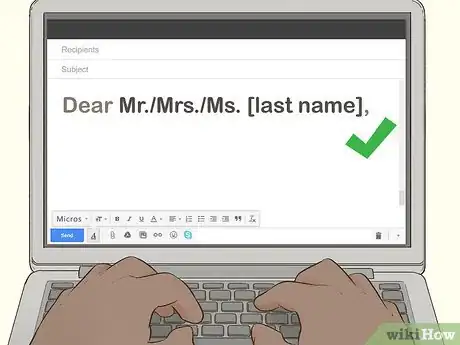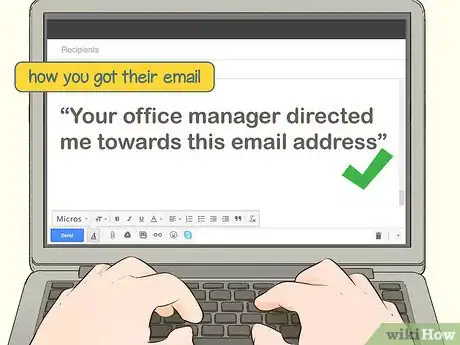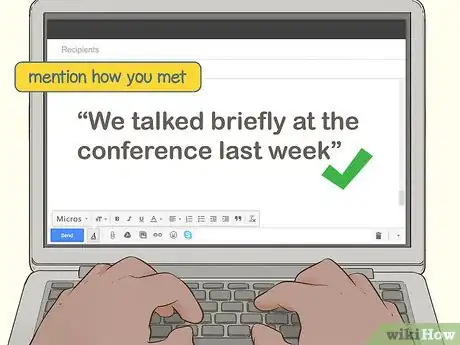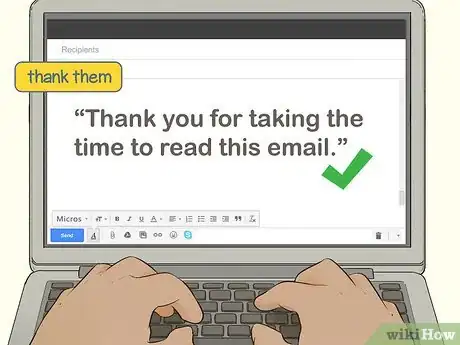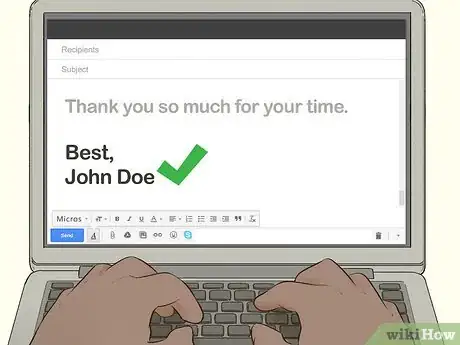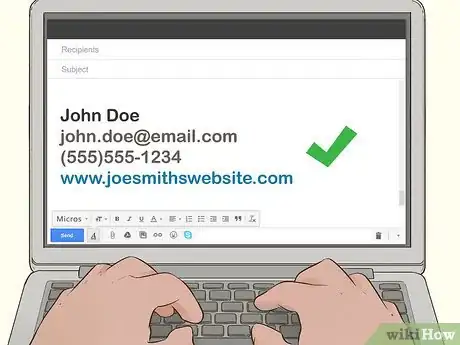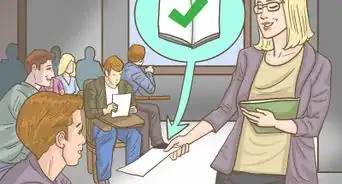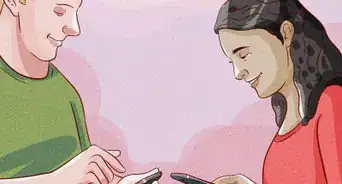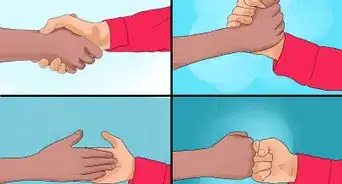This article was co-authored by Lucy Yeh. Lucy Yeh is a Human Resources Director, Recruiter, and Certified Life Coach (CLC) with over 20 years of experience. With a training background with Coaching for Life and Mindfulness-Based Stress Reduction (MBSR) at InsightLA, Lucy has worked with professionals of all levels to improve the quality of their careers, personal/professional relationships, self marketing, and life balance.
There are 7 references cited in this article, which can be found at the bottom of the page.
wikiHow marks an article as reader-approved once it receives enough positive feedback. This article has 18 testimonials from our readers, earning it our reader-approved status.
This article has been viewed 961,485 times.
Email is a common form of communication and knowing how to introduce yourself to someone in email can help your career and networking efforts. Writing a succinct and clear introductory email will increase the chances that your recipient will take the time to read it and engage with you. Avoid some of the more common mistakes to ensure that you stand out from the crowd.
Steps
Starting Strong
-
1Make your subject line clear. Your recipient should have a good idea about what the email is about before they even open it. Keep it short as well;[1] a long subject can be cumbersome. For an introductory email, it is usually perfectly acceptable to write "Introduction - Your Name".
- Mobile devices will typically only show about 25-30 characters of the subject, so keep it short.
Tip: Make sure to write the subject line first! A common mistake is to save the subject line for last, which can lead to forgetting to write it at all.
-
2Open with a business salutation. Don't start off with "Hello" or "Hi". You can use greetings like that once you've gotten to know the person. Start off with a tried-and-true business greeting. Avoid using the recipient's first name in the salutation.[2]
- "Dear Ms./Mr./Mrs." - If you are at all unsure about the marital status of the female you are emailing, you should always default to using "Ms." as it is less presumptuous.
- "To whom it may concern" - This should only be used if you are not sure who will be receiving the message.
Advertisement -
3Introduce yourself. Your first sentence should introduce yourself to your recipient. This allows them to associate a name with the rest of the email message.[3]
- "My name is..."
- Give your title if applicable. If you have multiple titles, don't list them all out, just the most important or relevant one.
Keeping it Concise
-
1Explain how you got the recipient's email address. Let the recipient know how you found out their contact information. This helps show that you went through the proper channels to reach them.[4] [5]
- "Your office manager directed me towards this email address"
- "I found this email address on your website"
- "So-and-so said that I should get in contact with you"
-
2Talk about the last time you met (if applicable). Jogging the person's memory can lead to more engagement.[6]
- "We talked briefly at the conference last week"
- "We spoke on the phone yesterday"
- "I saw your presentation on..."
-
3Share a common interest. This can help you relate to your recipient, and keeps your business emails from seeming too cold. In order to determine mutual interests, you may need to do a little research on the recipient. Possible research areas include Facebook, Twitter, and LinkedIn.[7]
- Make sure you let the person know where you found this mutual interest, otherwise you'll come off as a stalker.
- If possible, try to keep the mutual interest business-related, such as something in your field or a professional passion you both share.
-
4Give your reason for getting in touch. Don't wait too long to get to the point. No one is going to read an email that is multiple paragraphs long before anything resembling the point appears. Explain clearly and straightforwardly what you want and why you're contacting that person about it. If you are asking for advice or making some other request, make sure it is manageable, especially if this is your first contact.
- "I'm interested in learning more about..."
- "I'd like to meet with you sometime to discuss..."
- "I would like your opinion on..."
-
5Keep your email focused on one subject. Letting your email meander can cause your recipient to lose interest or forget about why you were emailing in the first place.
Tip: Only ask the recipient one thing in your email.
Signing Off
-
1Thank the recipient for their time. No one likes going through all of their email, so make sure to thank your recipient for taking the time to read yours. This simple courtesy will greatly improve your recipients mood and increase the chances of you getting a response.[8]
- "I appreciate you taking the time to read this email."
- "Thank you for taking time out of your schedule to read this."
-
2Provide a call to action. Ask the recipient to write you back, call, think about your proposal, or anything else to get them engaged. Asking a question is another great way to increase engagement.[9]
- "Give me a call when you have some free time"
- "Let's meet for lunch sometime soon"
- "What are your thoughts on...?"
- "I look forward to your response"
-
3End the email. When ending a professional email, make sure that your ending is grateful but concise. A simple ending salutation will keep your email professional while still expressing your gratitude.[10]
- "Sincerely,"
- "Thank You,"
- "Kind/Warm Regards,"
- "Best,"
- Avoid "Yours Truly," "Sincerely Yours," "Cheers!," "Peace," "Thank you for your consideration."
-
4Include your signature. If you haven't configured your email service to include your signature, make sure to end with your name, title, and contact information. Don't overload this part with five phone numbers, two email addresses and three websites. Keep it simple so that the recipient knows the best way to get back in touch with you. Avoid including quotes in your signature.[11]
- Joe Smith
- joe.smith@mail.com
- (555)555-1234
- www.joesmithswebsite.com
-
5Proofread the email. Before clicking the "Send" button, take some time to read through your email a couple times, correcting any errors that you find along the way. Since this email will likely be your first contact with the recipient, you need to leave the best impression possible. Misspellings and grammatical errors will quickly make your email look much less professional.
Expert Q&A
-
QuestionIs it okay to reach out about a job via email?
 Lucy YehLucy Yeh is a Human Resources Director, Recruiter, and Certified Life Coach (CLC) with over 20 years of experience. With a training background with Coaching for Life and Mindfulness-Based Stress Reduction (MBSR) at InsightLA, Lucy has worked with professionals of all levels to improve the quality of their careers, personal/professional relationships, self marketing, and life balance.
Lucy YehLucy Yeh is a Human Resources Director, Recruiter, and Certified Life Coach (CLC) with over 20 years of experience. With a training background with Coaching for Life and Mindfulness-Based Stress Reduction (MBSR) at InsightLA, Lucy has worked with professionals of all levels to improve the quality of their careers, personal/professional relationships, self marketing, and life balance.
Career & Life Coach Yes, that's perfectly fine in most cases, but you sort of want to make sure that you know who you're talking to. It's hard to build rapport over email, but it's a lot easier if you have some sort of common bond you can identify.
Yes, that's perfectly fine in most cases, but you sort of want to make sure that you know who you're talking to. It's hard to build rapport over email, but it's a lot easier if you have some sort of common bond you can identify. -
QuestionHow can I attach images to an email?
 Community AnswerYou can send images as an attachment by clicking on the "clip" button next to the "send" button. You can also embed your image in the email itself.
Community AnswerYou can send images as an attachment by clicking on the "clip" button next to the "send" button. You can also embed your image in the email itself.
References
- ↑ https://www.mindtools.com/CommSkll/EmailCommunication.htm
- ↑ http://www.englishforbusinesscommunication.com/how-to-formally-introduce-yourself-in-emails/
- ↑ Lucy Yeh. Human Resources Director. Expert Interview. 21 November 2019.
- ↑ https://fairygodboss.com/career-topics/how-to-introduce-yourself-in-an-email
- ↑ Lucy Yeh. Human Resources Director. Expert Interview. 21 November 2019.
- ↑ Lucy Yeh. Human Resources Director. Expert Interview. 21 November 2019.
- ↑ Lucy Yeh. Human Resources Director. Expert Interview. 21 November 2019.
- ↑ Lucy Yeh. Human Resources Director. Expert Interview. 21 November 2019.
- ↑ http://www.glassdoor.com/blog/introduce-networking-email/
About This Article
To introduce yourself via email, start by creating a concise subject line that communicates the purpose of your message. Next, open with a formal salutation and briefly explain who you are in the first sentence. If you're writing a business email, you can also include your job title. Then, quickly explain how you got the recipient’s email address before getting straight to the point of your message. Focus on one subject and include a call to action before signing off with a professional salutation. For more tips on keeping your email concise, read on!

